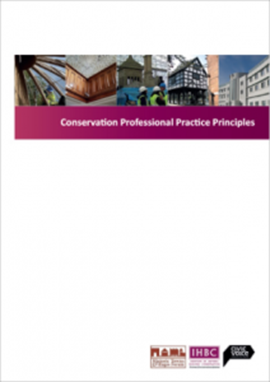Managing risks in building conservation projects
A most robust risk management strategy starts when one looks at a building for the first time and doesn’t end at the completion of a ‘project’ but through into the use and occupation of a building. A robust approach also involves employing a competent team and deploying the necessary activities and risk management tools and then understanding that when one moves away from this ideal that risks are increased. However, one has to be proportionate and through a cost benefit analysis the balance in what are deemed to be reasonable actions and activities can be ascertained.
Contents |
Introduction
There are many types of risks and although controlling costs and completion dates often steal the headlines, one must also manage the risk of not specifying the most appropriate work and making sure that work is properly undertaken and that optimum quality standards are achieved.
The most critical initial stage starts with the appointment of the consultant or in-house team that follows BS 7913: 2013: Guide to the Conservation of Historic Buildings which sets out the overall process in the undertaking of work to historic and traditional older buildings. Here it describes competence and cites accreditation (also known as certification) as a means of identifying suitable personnel. This is one way of minimising risk – having the most competent personnel on board.
Understanding the building
There are greater risks in dealing with existing buildings compared to constructing new ones. There can be uncertainty over the exact design and condition. We also need to understand a buildings significance.
It is not uncommon to find that a building’s condition is worse than one thought and to expose features that were previously unknown and therefore be mindful that we will find out more about a structure as we progress through a project. However, we should aim to keep the risk of ‘unknowns’ to an absolute minimum.
Such risks can be minimised if their possibility is understood at the outset and that a well thought out strategy is developed at that stage, but it needs to be properly resourced and implemented. The strategy should stretch into the ongoing management of a building and not end at the completion of a project.
At the outset, a risk management strategy must focus on the logical stages and the initial ones are as follows:
- a) Understanding its design, the materials it is made from and it chronological stages of development and the full implications of this.
- b) Understand the significance and the elements, groups of elements and features that make up the building. We must also understand their vulnerability.
- c) Understand the condition.
The more work put into undertaking the above, the less risks we take. However, one has to be proportionate and consider the cost benefit analysis and there will be a limit to the amount of work undertaken at these stages to where it may be considered unreasonable.
As for (a) and (c ) above, the amount and quality of information derived will depend on:
- The type of building survey – the choices of a pure visual inspection or a building pathological analysis.
- The competence of the surveyor – conservation accredited or certified or not? This can make a very big difference to the outcome.
- The equipment used – this can range from a simple electric moisture meter to a range of surveying equipment that can test the strength of materials, analyse true moisture levels and source, environmental conditions and much more.
Interventions
All interventions will be reliant on the above and the extent to which the building is understood will have a huge bearing on the risks taken. Properly understanding the impact of all types of interventions including repair is essential. Repairs need to focus on the problems that cause the need to repair and if not then we take a risk in problems re-occurring. If a repair is not like for like, then they risk an adverse effect on significance. Therefore, a heritage impact assessment needs to be undertaken. If this process is properly followed by those with the required competence, the risk of inappropriate and technically unsound repairs will be minimised.
When planning to adapt a building the same elements of risk exist, but these can be even greater. Older buildings may have been performing in a reasonable way for a hundred years or more, but when adaptations are made this can have a huge impact, but this depends on the form of the adaptation. Risks can be managed if we understand the building and all the issues sufficiently.
Procurement of work
Only selecting contractors that have specific suitability for the project in question would be a good starting point and this could be achieved by a range of activities that includes looking at previous work – recent and historic, talking to ex clients, obtaining the CV’s of those working on the project, looking at the contractors management structure and noting the expertise of individuals. The extent to which this is implemented depends on the size of the project and it could be that the contractors are so well known that not all of this would be necessary. However, any reduction in the above will increase risks.
There are several procurement options available that will have advantages and disadvantages. It is important to choose one that can provide the best results at minimum risk, but also making sure that responsibilities are clearly understood and backed up in contracts.
The contractor will always be taking some risk in terms of his tender and what he has allowed for. Such risks need to be reasonable and if excessive risk is put onto the contractor a higher tender sum may result or tenders not received.
Programming
Clients and their consultant team will programme a project before appointing a contractor and need to be aware that there are many things leading up to the commencement of a project that may take longer than expected. Examples include consent to undertake work and this is where using competent advisors will help to reduce risks of uncertainty. It is always possible that the scope may change as the work is progressed and a client needs to understand this particularly if there is reliance upon occupying the building soon after completion of a project. The weather can affect the work and choosing the most appropriate time of year to execute the works will reduce this risk. However, specifying specific protection measures will also reduce this risk.
Cost management
Controlling the scope is essential if costs are to be controlled. The risk that the work will vary and may increase must be accepted at the outset and a framework must be put in place to ensure that the cost of the work including any variation of it is fairly tendered and any extension of a contract necessary due to the increase and / or variation of work is on the basis of the original tender sum or pro rata.
This means that the sums received from each tendering contractor should each be broken down consistently between all tenders received. The only way of achieving this is for a measured schedule of works to be produced for all competing contractors to price. This may include provisional quantities and quantities which are an estimate of what might be required. This will help to manage the risk of the client paying inflated prices for works which are in addition to those specified.
Quality management
Ensuring that the specification is complied with is essential and BS 7913: 2013 contains advice through project supervision. This emphasises that simply checking over the work on completion may not always be adequate and bearing in mind that some defects brought about by specification non-compliance may not reveal themselves for many years, a more concerted approach is necessary in order to reduce these risks.
It is a contractors responsibility to ensure specification compliance and not a clerk or works, architect or any other member of the design team. However, work should only be certified as complete on either an interim or final basis if it is compliant with the specification.
BS 7913: 2013 highlights a risk management approach to managing specification compliance and quality. It requires at the outset for the specifiers to detail areas of work which are high priority as far as a proactive approach to managing quality is concerned. It means that where it is not possible to determine whether an item of work has been properly implemented just by inspecting it on completion, the contractor has to propose a method (within a project execution plan) by which he will manage the quality of work and evidence this to the architect/ building surveyor or other client representative. It is the responsibility of the architect/ building surveyor to be satisfied and he/ she can undertake his/ her own inspections and tests as necessary. This is a way in which the risk of specification noncompliance can be reduced.
There are many activities that one would expect to see within a contractors project execution plan that include inspections at certain times along with tests and also things such as managing the storage of materials and such like.
Soft landing
If a project has been properly initiated and brought through to completion with all risks understood and managed then the building should be appropriate for its intended occupation, but if there are any limitations on what this occupation means, then this information must be understood by the occupants and managers of the building.
It is also important from the inception stage of a project, that appropriate expertise in the use and operation of the building is deployed as this will minimise the risk of adapting a building in a way that minimises risk of unsuitability. This may include operational and commercial expertise.
Putting risk management into practice
All the various possible risks need to listed at the very beginning of a project and put into a risk register. Here they can be assessed, their means of mitigation determined and recommendations made. This may include the most ideal means of managing the risks along with second, third and perhaps other options. There will no doubt be instances when implementation of risk mitigation may be reliant upon the client’s willingness to put in sufficient resource.

|
|
Fig 1: At Cardiff Castle project risks were managed in several ways including an extensive research and analysis programme, proactive quality management including a form of contract to consolidate the approach and an ongoing building management regime that included environmental control. Image: Cardiff Council |

|
|
Fig 2: A major repair and refurbishment project at Trafalgar Square in Sunderland where the reintroduction of vapour permeability ultimately means managing the risk of residents applying impermeable decoration through the supply of permeable paint by the landlord to each resident on an ongoing basis. Image: John Edwards. |
Prof John Edwards MA, DipBldgCons, CEnv, FRICS, FCIOB, IHBC is Director of Edwards Hart Chartered Surveyors and Historic Building Consultants and lead author of BS 7913: 2013: Guide to the conservation of historic buildings; RICS iSURV lead author on Managing Risk in Building Conservation and Professor on Practice at the University of Wales Trinity St David: [email protected]
--Institute of Historic Building Conservation
Find out more
Related articles on Designing Buildings Wiki
IHBC NewsBlog
Heritage Building Retrofit Toolkit developed by City of London and Purcell
The toolkit is designed to provide clear and actionable guidance for owners, occupiers and caretakers of historic and listed buildings.
70 countries sign Declaration de Chaillot at Buildings & Climate Global Forum
The declaration is a foundational document enabling progress towards a ‘rapid, fair, and effective transition of the buildings sector’
Bookings open for IHBC Annual School 12-15 June 2024
Theme: Place and Building Care - Finance, Policy and People in Conservation Practice
Rare Sliding Canal Bridge in the UK gets a Major Update
A moveable rail bridge over the Stainforth and Keadby Canal in the Midlands in England has been completely overhauled.
'Restoration and Renewal: Developing the strategic case' Published
The House of Commons Library has published the research briefing, outlining the different options for the Palace of Westminster.
Brum’s Broad Street skyscraper plans approved with unusual rule for residents
A report by a council officer says that the development would provide for a mix of accommodation in a ‘high quality, secure environment...
English Housing Survey 2022 to 2023
Initial findings from the English Housing Survey 2022 to 2023 have been published.
Audit Wales research report: Sustainable development?
A new report from Audit Wales examines how Welsh Councils are supporting repurposing and regeneration of vacant properties and brownfield sites.
New Guidance Launched on ‘Understanding Special Historic Interest in Listing’
Historic England (HE) has published this guidance to help people better understand special historic interest, one of the two main criteria used to decide whether a building can be listed or not.
"Conservation Professional Practice Principles" to be updated by IHBC, HTVF, CV
IHBC, HTVF, and CV look to renew this cross-sector statement on practice principles for specialists working in built and historic environment conservation roles.

















